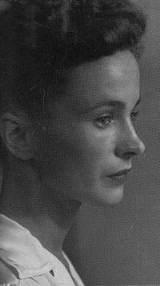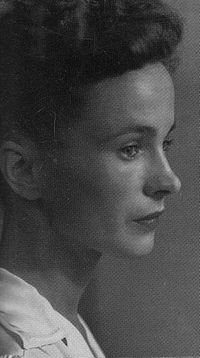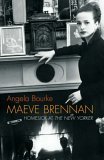
Maeve Brennan
Encyclopedia

Ireland
Ireland is an island to the northwest of continental Europe. It is the third-largest island in Europe and the twentieth-largest island on Earth...
short story
Short story
A short story is a work of fiction that is usually written in prose, often in narrative format. This format tends to be more pointed than longer works of fiction, such as novellas and novels. Short story definitions based on length differ somewhat, even among professional writers, in part because...
writer and journalist
Journalist
A journalist collects and distributes news and other information. A journalist's work is referred to as journalism.A reporter is a type of journalist who researchs, writes, and reports on information to be presented in mass media, including print media , electronic media , and digital media A...
. She moved to the United States in 1934 when her father was appointed to the Irish Legation in Washington. She was an important figure in both Irish diaspora
Irish diaspora
thumb|Night Train with Reaper by London Irish artist [[Brian Whelan]] from the book Myth of Return, 2007The Irish diaspora consists of Irish emigrants and their descendants in countries such as the United Kingdom, the United States, Canada, Australia, Argentina, New Zealand, Mexico, South Africa,...
writing and in Irish writing itself. Collections of her articles, short stories, and a novella
Novella
A novella is a written, fictional, prose narrative usually longer than a novelette but shorter than a novel. The Science Fiction and Fantasy Writers of America Nebula Awards for science fiction define the novella as having a word count between 17,500 and 40,000...
have been published.
Early life
She was born in Dublin, Ireland and grew up in the Dublin suburb of RanelaghRanelagh
Ranelagh is a residential area and urban village on the south side of Dublin, Ireland. It is in the postal district of Dublin 6. It is in the local government electoral area of Rathmines and the Dáil Constituency of Dublin South-East.-History:...
. Her parents, Robert and Una, were Republicans
Irish Republicanism
Irish republicanism is an ideology based on the belief that all of Ireland should be an independent republic.In 1801, under the Act of Union, the Kingdom of Great Britain and the Kingdom of Ireland merged to form the United Kingdom of Great Britain and Ireland...
and were deeply involved in the Irish political and cultural struggles of the early twentieth century. Robert Brennan
Robert Brennan (journalist)
Robert Brennan was an Irish writer, diplomat and a founder of The Irish Press newspaper. He took part in the 1916 Easter Rising and later became the Irish Free State's first minister to the United States.-Life:...
(1881–1964) participated in the 1916 Easter Rising and was sentenced to death. The sentence was commuted to penal servitude. His continuing political activity resulted in further imprisonments in 1917 and 1920. Maeve was born while he was in prison. He was director of publicity for the anti-Treaty Irish Republican Army during the Irish Civil War
Irish Civil War
The Irish Civil War was a conflict that accompanied the establishment of the Irish Free State as an entity independent from the United Kingdom within the British Empire....
. He also founded and was the director of The Irish Press
The Irish Press
The Irish Press was an Irish national daily newspaper published by Irish Press plc between 5 September 1931 and 25 May 1995.-Foundation:...
newspaper. His imprisonments and activities greatly fragmented Maeve Brennan's childhood. In her story The Day We Got Our Own Back she recounts her memory of how, when she was five, her home was raided by Free State
Irish Free State
The Irish Free State was the state established as a Dominion on 6 December 1922 under the Anglo-Irish Treaty, signed by the British government and Irish representatives exactly twelve months beforehand...
forces looking for her father, who was on the run.
Robert Brennan was appointed the Irish Free State's first minister to the United States, and the family moved to Washington, D.C.
Washington, D.C.
Washington, D.C., formally the District of Columbia and commonly referred to as Washington, "the District", or simply D.C., is the capital of the United States. On July 16, 1790, the United States Congress approved the creation of a permanent national capital as permitted by the U.S. Constitution....
in 1934, when Maeve was seventeen. She read English at the American University
American University
American University is a private, Methodist, liberal arts, and research university in Washington, D.C. The university was chartered by an Act of Congress on December 5, 1892 as "The American University", which was approved by President Benjamin Harrison on February 24, 1893...
in Washington. Maeve and two of her sisters remained in the United States when her parents and brother returned to Ireland in 1944.
Career
Brennan moved to New York and found work as a fashion copywriter at Harper's BazaarHarper's Bazaar
Harper’s Bazaar is an American fashion magazine, first published in 1867. Harper’s Bazaar is published by Hearst and, as a magazine, considers itself to be the style resource for “women who are the first to buy the best, from casual to couture.”...
in the 1940s. She also wrote a Manhattan column for the Dublin society magazine Social and Personal, and wrote several short pieces for The New Yorker magazine. In 1949, she was offered a staff job by William Shawn
William Shawn
William Shawn was an American magazine editor who edited The New Yorker from 1952 until 1987.-Education and Early Life:...
, The New Yorker's managing editor.
Brennan first wrote for The New Yorker as a social diarist. She wrote sketches about New York life in The Talk of the Town section under the pseudonym "The Long-Winded Lady". She also contributed fiction criticism, fashion notes, and essays. She wrote about both Ireland and the United States.
The New Yorker began publishing Brennan's short stories in 1950. The first of these stories was called The Holy Terror. In it, Mary Ramsay, a "garrulous, greedy heap of a woman" tries to keep her job as a ladies room attendant in a Dublin hotel.
Brennan's work was fostered by William Maxwell
William Keepers Maxwell, Jr.
William Keepers Maxwell, Jr. was an American novelist and editor.-Life:Maxwell was born in Lincoln, Illinois, and as a child, he survived the 1918 Influenza epidemic. He attended the University of Illinois and Harvard University...
, and she wrote under The New Yorker managing editors Harold Ross
Harold Ross
Harold Wallace Ross was an American journalist and founder of The New Yorker magazine, which he edited from the magazine's inception in 1925 to his death....
and William Shawn
William Shawn
William Shawn was an American magazine editor who edited The New Yorker from 1952 until 1987.-Education and Early Life:...
. Although she was widely read in the United States in the 1950s and 1960s, she was almost unknown in Ireland, even though Dublin was the setting of many of her short stories.
A compendium of her New Yorker articles called The Long-Winded Lady: Notes from the New Yorker was published in 1969. Two collections of short stories, In and Out of Never-Never Land (1969) and Christmas Eve (1974) were also published.
Personal life
Brennan was admired in New York society for her intelligence, wit, beauty, and style. She was a petite woman who frequently dressed in black and liked wearing large, dark glasses. She was eccentric, and never lived in any place for a long period of time. She was generous with her money, but she also liked to buy extravagant things and tended to live beyond her means. She occasionally visited Ireland, but was conspicuous in Ireland's religious and conservative society.While the love of her life was reportedly the writer and theatre critic / director Walter Kerr
Walter Kerr
For the RN admiral see Lord Walter KerrWalter Francis Kerr was an American writer and Broadway theater critic. He also was the writer, lyricist, and/or director of several Broadway plays and musicals.-Biography:...
, he broke off their engagement and married someone else. In 1954, Brennan married St. Clair McKelway
St. Clair McKelway
St. Clair McKelway was a writer and editor for The New Yorker magazine beginning in 1933. He was brought up in Washington D.C., and began his journalistic career as an office boy at the Washington Herald...
, The New Yorker's managing editor. McKelway had a history of alcoholism, womanizing and manic depression and had already been divorced three times. Brennan and McKelway divorced after five years.
Edward Albee
Edward Albee
Edward Franklin Albee III is an American playwright who is best known for The Zoo Story , The Sandbox , Who's Afraid of Virginia Woolf? , and a rewrite of the screenplay for the unsuccessful musical version of Capote's Breakfast at Tiffany's . His works are considered well-crafted, often...
greatly admired Brennan and compared her to Chekov and Flaubert. One of the characters in his play Quotations from Chairman Mao Tse-Tung is called "Long-Winded Lady." He dedicated the published editions of Quotations from Chairman Mao Tse-Tung (1968) and Box (1968) to her.
Brennan was writing consistently and productively in the late 1960s. By the time her first books were published, however, she was showing signs of mental illness. Her previously immaculate appearance became unkempt. Her friends began to find her eccentricities disturbing rather than entertaining. She became obsessive.
In the 1970s Brennan became paranoid and was an alcoholic. She was hospitalized a number of times. She became destitute and homeless, and frequently slept in the women's lavatory at The New Yorker. She was last seen at the magazine's office in 1981.
In the 1980s, Brennan vanished from view and her work was forgotten. After wandering from one transient hotel to another along 42nd Street
42nd Street (Manhattan)
42nd Street is a major crosstown street in the New York City borough of Manhattan, known for its theaters, especially near the intersection with Broadway at Times Square. It is also the name of the region of the theater district near that intersection...
, she was committed to Lawrence Hospital. She died in 1993 at the age of seventy-six and is buried in Queens, New York City.
Works
Brennan's writing style in her "Long-Winded Lady" pieces and in her short stories are quite different both in style and content.The New Yorker articles
Brennan's contributions as "The Long-Winded Lady" in The New Yorker are sardonic observations of New York life. In them, Brennan mocks ManhattanManhattan
Manhattan is the oldest and the most densely populated of the five boroughs of New York City. Located primarily on the island of Manhattan at the mouth of the Hudson River, the boundaries of the borough are identical to those of New York County, an original county of the state of New York...
society and social tradition, but in a humorous, wistful, and often melancholy manner. In these stories she is an observer eavesdropping on strangers' conversations in bars, diners, hotel lobbies, and streets in places like Times Square
Times Square
Times Square is a major commercial intersection in the borough of Manhattan in New York City, at the junction of Broadway and Seventh Avenue and stretching from West 42nd to West 47th Streets...
and Greenwich Village
Greenwich Village
Greenwich Village, , , , .in New York often simply called "the Village", is a largely residential neighborhood on the west side of Lower Manhattan in New York City. A large majority of the district is home to upper middle class families...
. She then embellishes her observations with speculations and autobiographical details. Brennan is always an onlooker in these sketches, never a participant. For example, she watches a street protest against the Vietnam War
Vietnam War
The Vietnam War was a Cold War-era military conflict that occurred in Vietnam, Laos, and Cambodia from 1 November 1955 to the fall of Saigon on 30 April 1975. This war followed the First Indochina War and was fought between North Vietnam, supported by its communist allies, and the government of...
from a window, but does not venture out onto the street. A compendium of her articles was published in 1969.
Short stories
Brennan's short stories are written in a simple, direct, and elegant style. She writes with a minimum of characters and plot. Some of her stories are quietly tender and poignant while others are satirical. The characters are emotionally unreachable and often lead stagnant lives where everything remains much the same. She often repeats characters from story to story, for example, Hubert and Rose Derdon, who marriage is examined over stories set years apart. In the final Derdon story, The Drowned Man, Rose has died and Hubert has to pretend that he is overwhelmed with grief for his dead wife, "...she was gone, she had been good, and he wished he could miss her."The main themes in Brennan's short stories are feelings of loneliness, vulnerability, despair, spite, and fear. She often wrote about unhappy, loveless marriages and people with claustrophobic, sad and disappointed lives. Her studies of these relationships sometimes have a cruel tone. Another theme is about how the individual's need for expression is countered and restricted by the need for societal acceptance in a country that clung to traditions steeped in the church and strict convention. For example, in The Devil In Us she describes a convent school that uses morals to cruelly stop any type of nonconformity.
Brennan also wrote stories set in or around Manhattan, which she described as "the capsized city—half-capsized, anyway, with the inhabitants hanging on, most of them still able to laugh as they cling to the island that is their life's predicament." These stories tend to be more satiric in tone, and she often parodies middle-class pretensions.
Brennan's stories about her cats, dog and Long Island beach cottage show her mistrust of human nature and love of solitude and innocence.
Two collections of Brennan's short stories were published in her lifetime: In and Out of Never-Never Land was published in 1969 and Christmas Eve was published in 1974. These collections were well received in the U.S.A., but they were no paperback editions. None of her books were published in Ireland or the UK
Novella
Brennan wrote a novella, The Visitor, in the 1940s, but it was not published until 2000, after the only known copy of the manuscript was discovered in the archives of The University of Notre Dame.The Visitor is about the destructive power of family pride and anger. In it, a 22-year-old woman called Anastasia King returns to Dublin to live with her grandmother after her parents die. Anastasia's mother had left her husband and his judgemental, domineering mother and had moved to Paris
Paris
Paris is the capital and largest city in France, situated on the river Seine, in northern France, at the heart of the Île-de-France region...
. Her grandmother is angry with Anastasia for choosing to live with her mother rather than her father. Desperate to stay in her childhood home, Anastasia tries to break through the wall of loneliness and isolation that surrounds her grandmother, but, as her efforts fail, loneliness threatens to envelop her in a detachment as cruel as that of her grandmother.
Posthumous publications

Houghton Mifflin
Houghton Mifflin Harcourt is an educational and trade publisher in the United States. Headquartered in Boston's Back Bay, it publishes textbooks, instructional technology materials, assessments, reference works, and fiction and non-fiction for both young readers and adults.-History:The company was...
, published both a new, larger, collection of Brennan's "Long-Winded Lady" pieces and The Springs of Affection, a volume of her short stories. William Maxwell provided the introduction for The Springs of Affection.
The discovery and publication of The Visitor also helped to revive interest in Brennan. She was also mentioned in Roddy Doyle
Roddy Doyle
Roddy Doyle is an Irish novelist, dramatist and screenwriter. Several of his books have been made into successful films, beginning with The Commitments in 1991. He won the Booker Prize in 1993....
's book Rory and Ita as a cousin of his mother who stayed with his family and wrote book reviews for The New Yorker in the garden.
In 2004, Angela Bourke's biography Maeve Brennan: Homesick at the New Yorker was published. In it, Bourke speculates that Brennan may have been the inspiration for the character Holly Golightly in Truman Capote
Truman Capote
Truman Streckfus Persons , known as Truman Capote , was an American author, many of whose short stories, novels, plays, and nonfiction are recognized literary classics, including the novella Breakfast at Tiffany's and the true crime novel In Cold Blood , which he labeled a "nonfiction novel." At...
's novella Breakfast at Tiffany's
Breakfast at Tiffany's (novella)
Breakfast at Tiffany's is a novella by Truman Capote published in 1958. The main character, Holly Golightly, is one of Capote's best-known creations and an American cultural icon.-Plot:...
(1958). The two had worked together at both Harper's Bazaar and The New Yorker.
Fiction
- In and Out of Never-Never Land (1969)
- Christmas Eve (1974)
- The Springs of Affection: Stories of Dublin (1997)
- The Rose Garden: Short Stories (2000)
- The Visitor (2000)
Non fiction
- The Long-Winded Lady: Notes from the New Yorker (1969)
- The Long-Winded Lady: Notes from the New Yorker (1998)

